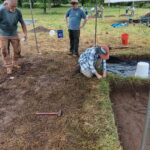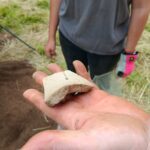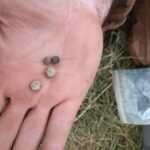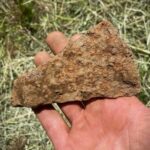 I must confess that I enjoy watching Time Team, a British television show where a team of archaeologists must uncover the answer to a question and have only three days to do it. It seems most people, like Tony Robinson, the host, expect to hear about beautiful finds, which, in the past, was also what antiquarians were seeking. Artifacts such as mosaic floors, gold coins, marble statues, etc., were highly sought after, and the features themselves were often ignored. Very few reports were published, and little documentation exists about these excavations. Fortunately, the evolution of archaeology as a science has advanced from a treasure-hunting pastime to a rigorous discipline using an array of technologies to understand the human past, which contributes to our understanding of previous cultures.
I must confess that I enjoy watching Time Team, a British television show where a team of archaeologists must uncover the answer to a question and have only three days to do it. It seems most people, like Tony Robinson, the host, expect to hear about beautiful finds, which, in the past, was also what antiquarians were seeking. Artifacts such as mosaic floors, gold coins, marble statues, etc., were highly sought after, and the features themselves were often ignored. Very few reports were published, and little documentation exists about these excavations. Fortunately, the evolution of archaeology as a science has advanced from a treasure-hunting pastime to a rigorous discipline using an array of technologies to understand the human past, which contributes to our understanding of previous cultures.
Often, the actual artifacts, the things that tell us the most about how people lived, are the simple everyday items they used. Bits of pottery, projectile points, musket balls, bone combs, and cast-iron pots are examples of items that can reveal how people lived. More elusive are the homes in which they lived. Unless they were built of materials like stone or brick, they degrade over time, leaving nothing but shadows in the soil of what once stood on the site.
 Such was the case this past week as we dug for evidence of the home of Thomas Cresap, an 18th-century frontiersman who featured heavily in the history of the Maryland colony. Known by Pennsylvanians as the Maryland Monster for his tactics in staving off the tax collector and sheriff from the colony of Pennsylvania, he is a minor character in Death on the Line, the first book in my MacKay Mysteries series.
Such was the case this past week as we dug for evidence of the home of Thomas Cresap, an 18th-century frontiersman who featured heavily in the history of the Maryland colony. Known by Pennsylvanians as the Maryland Monster for his tactics in staving off the tax collector and sheriff from the colony of Pennsylvania, he is a minor character in Death on the Line, the first book in my MacKay Mysteries series.
Using modern technologies, such as magnetometry and ground-penetrating radar, the archaeologists found what they believed to be Thomas Cresap’s fortified home and trading post. Locals believed it to be at the top of a hill near the northern branch of the Potomac River. However, only 19th—and 20th-century artifacts had been discovered on the hilltop. The 18th-century items were all below along the creek.
Their results showed signs of two cellars, one smaller than the other, as well as a line of three postholes that might indicate a palisade structure, which is mentioned in records of the time. Documents from the time back this up as several people wrote about visiting Thomas Cresap, including a 16-year-old George Washington, who wrote the following:
“March 15th, Tuesday.—We set out early and arrived at Cresap’s in the afternoon; we traveled over hills and dales, through very thick woods, crossed several small runs of water, and a great deal of mire and swamp, we also passed by the plantation of Captn. Rutherford, and the plantations of Mr. Vale. It is situated on the fork of the Potomack, about two miles from the river, and lies in Maryland. The house is built of stone and extremely good, it is an exceeding good building, and looks new. He is an exceeding good liver, keeps open house, and has a universal  acquaintance.”
acquaintance.”
Washington and others mention that the house and storeroom were located along the lowlands, near the creek. That would make sense for someone who relied on trade goods. The site was located along a trail used by Native Americans for travel and trade. Known as the “Warrior’s Path,” it played a crucial role in movement through the region.
With their results backing up the written records, the site was chosen for the Archaeological Society of Maryland’s Field School this year. I was interested for three reasons: a local dig in a period that interests me, the research I had done on Thomas Cresap for my novel, and that my Howell ancestors lived in the exact location at the same time. I had to go.
The adventure did not disappoint. The finds were what we anticipated, all consistent with items one would find in a home and trading post in the mid-1700s. In the larger area presumed to be the house, we found brick, window glass, and square nails indicating a structure. We found pottery sherds, broken glass bottles, bone, buttons, flints, and many pipe stems. I even found a pig’s tooth! In the area they believed to be the store room, glass shards from larger vessels, as well as balls of lead shot, were found. Both French and English gun flints were discovered there, but the best find in that space was the head of a trade axe.
 Throughout the site, we found evidence of settlers and indigenous people. Numerous projectile points were found, some dating as far back as 3,000 years. Chert cores from flint knapping were found in both the house and the store room.
Throughout the site, we found evidence of settlers and indigenous people. Numerous projectile points were found, some dating as far back as 3,000 years. Chert cores from flint knapping were found in both the house and the store room.
The Delaware (Lenape) chief Nemacolin was known for the trail he blazed through the Allegany Mountains. Later, working with Thomas Cresap, the two men widened and improved “Nemacolin’s Path.” Their efforts in developing the trail contributed to the American expansion and the complex interactions between Native American tribes and European settlers.
Though we unearthed a good number of artifacts, our mission was to trace the outlines of the former structures on the site. Finding these shadows in the soil can be a challenge and often reveals unexpected results. In Unit 7, where I worked in the house trench, we continued the line discovered in the earlier test pit. It followed a line to the northeast, where they expected it to intersect Unit 8. However, two-thirds of the way across, it took a sharp 90-degree turn to the northwest, leading us to open a new unit north of the previous one. The next morning, about halfway across the new unit an unexpected turn back toward the northeast appeared.
 Where this outline leads and the overall shape of the structure remains to be seen. However, following these faint lines left in the soil will one day reveal the outline of Thomas Cresap’s home in Maryland. While Tony Robinson may be disappointed with finding merely the outlines of these ephemeral structures, I was excited about them and cannot wait to learn more.
Where this outline leads and the overall shape of the structure remains to be seen. However, following these faint lines left in the soil will one day reveal the outline of Thomas Cresap’s home in Maryland. While Tony Robinson may be disappointed with finding merely the outlines of these ephemeral structures, I was excited about them and cannot wait to learn more.
